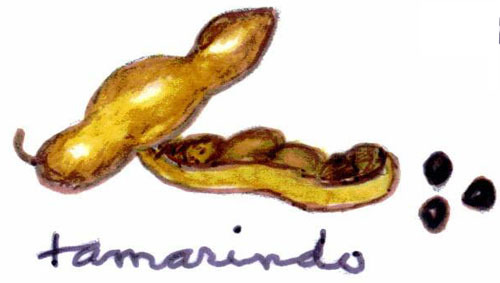Mexican Kitchen

One of my younger daughter’s most vivid food memories of Mexico was her first taste of tamarind candy. As a newly-arrived fourth grader, fascinated by the huge assortment of candies available nearly everywhere, from the dulcerías to the corner store, she seemed determined to try all of them. But the one that hooked her, with its tangy, sweet-tart taste, was the sugar and chile flavored dulce de tamarindo.
This candy came in several forms, from the delicious, homemade version sold at the regional candy booths at fairs, to the gimmicky bald clown that produced streams of tamarind paste candy through the holes in his head when squeezed.
At its best, the tamarind candy sold at fairs was a wholesome sweet. But even better was my daughter’s discovery of the fruit itself, which she and her friends would devour by the kilo. Whether it is because of the ritual of opening the pods and sucking on the pulp, the taste of the tamarind itself, or a combination of the two, children love tamarind. And, as it turns out, so do adults.
Agua de tamarindo has long been one of the most common of Mexico’s refreshing fruit aguas, but lately tamarind has been making appearances on cocktail menus in most of the country’s larger cities. I recently ordered a tamarind margarita at Mexico City’s Casa Lamm to see what the fuss was about, and was surprised at the way the tamarind could add a new dimension of flavor without overpowering the essential tequila-lime-Cointreau combination. Tamarind daiquiris are also gaining popularity, especially for those who prefer rum.
And tamarind’s unique, and some say addictive, flavor is not limited to candy and beverages. In many parts of Mexico it is used in table salsas and in seasoning pork, poultry, fish and seafood. A perusal of the Larousse de la Cocina Mexicana yielded a tamarind salsa from Guerrero, which makes perfect sense given the abundance of fish and seafood found along that state’s Pacific coast.
Tamarind is especially good in glazes and sauces for grilled foods. Honey is a good sweetener to balance the tartness of the tamarind, and chipotle, with its smoky flavor, is a good choice to add some heat. In Michoacan, tamarind is used to flavor the corn beverage atole. It is also used to make the ice pops called paletas and to make sherbet.
But where exactly did this fruit come from, and how did it become so widely used in Mexico? The answer, as with many other Mexican culinary questions, lies in Asia, and more specifically, with the Spanish galleons that plied the waters between Mexico and the Philippines during the Colonial era.
The voyage from Acapulco to the Philippines was not a difficult one, and though the return trip was not as easy, by 1570 the Spaniards had discovered a more navigable return route. Thereafter, the Manila galleons were returning to Mexico with all manner of furniture, textiles and foodstuffs. The tamarind, along with that other Mexican staple fruit, the mango, was one of the Asian imports that flourished here. The first reference to tamarind in the Americas is from Acapulco in 1615.
Although long naturalized in India, the East Indies and the islands of the Pacific, tamarind originated in tropical Africa. However, it thrived so well in India and became so strongly associated with that land that the word tamarind means “Indian date”, derived from the Arabic tamar hindi. The fruit’s scientific name, Tamarindus indica, also perpetuates the idea that the fruit was originally from India.
Of all the Latin American countries where the tamarind was introduced, it became most widespread in Mexico, where today over 10,000 acres of land are planted with it. The states of Chiapas, Colima, Guerrero, Jalisco, Oaxaca and Veracruz are the country’s largest producers of the fruit.
The tamarind is a slow-growing, long-lived evergreen tree. Its dense, feathery foliage makes it an attractive shade tree in tropical climates from Florida to Brazil. Its small yellow flowers are streaked with orange or red. But the main attraction, at least for cooks, is the fruit- a long, brown pod (about 3 to 8 inches) with irregular curves.
As the pods ripen, turning from green to brown, they fill out with a juicy, acidulous, reddish brown pulp. When fully ripe, the pods become brittle and easily broken. When this happens, the pulp dehydrates into a sticky paste with a distinctive sweet-and-sour flavor, high in acid and fructose. The seeds contained in the pod are flat, glossy, blackish-brown ovals and are embedded in the flesh.
These seeds are present in pulpa de tamarindo, the tamarind paste sold in Mexican markets. It needs to be mixed with a bit of water to loosen it up and remove the seeds by rubbing the mixture with the fingers. The tamarind paste sold in the U.S. is more concentrated and has had the seeds removed. Tamarind syrup, ready to mix with water to make agua de tamarindo, is also sold, although many people buy the pods and remove the pulp themselves. Tamarind flavored soft drinks are also sold in Mexico and in parts of the U.S. with significant Latino populations. Tamarind paste is available online at mexgrocer and the syrup can be ordered at fine products international or through the Amazon website.
Tamarind, besides being a good source of B vitamins, calcium and potassium, is being studied as a possible cholesterol-lowering agent, and an extract from its seeds is made into eye drops to treat dry eye syndrome. A healthy food as well as a great flavoring agent, tamarind is worth trying in drinks, sweets, sauces, glazes and marinades. Its sweet-tart taste is particularly refreshing in the cold drinks and grilled dishes of summer.
- Tamarind margaritas:Margaritas de tamarindo
- Tamarind water: Agua de tamarindo
- Grilled tamarind shrimp:Camarones al tamarindo a la parilla
- Pork chops with tamarind orange glaze: Chuletas de puerco con tamarindo y naranja
- Tamarind chicken: Pollo al tamarindo
- Tamarind candy: Dulce de tamarindo
- Tamarind atole: Atole de tamarindo


